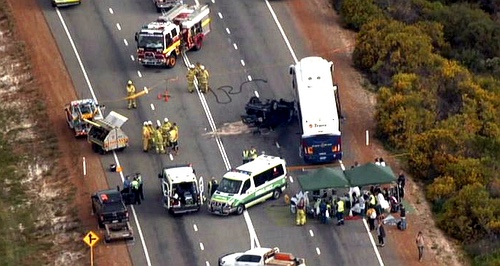Make / Model Search
News - General News - SafetyRoad toll back to pre-COVID levels: reportA HEAVY TOLL: The Australian road toll eased somewhat during the lockdowns of 2020, but has since risen to pre-COVID levels. Govt figures show 2.7% increase in road fatalities over 12 months, with speeding the leading cause of accidents5 May 2022 By MATT BROGAN A REPORT published this week by Savvy Finance shows Australia’s road fatalities are back to pre-COVID levels with a 2.7 per cent spike in the road toll observed over the past 12 months – the largest increase in almost four years.
Eleven hundred and thirty-eight people have died in road accidents nationally since February 2021, with a total of 1133 road fatalities recorded during the calendar year.
Of those, 559 included the death of the driver – up from 545 driver deaths in the year prior (2020) – 229 involved a motorcyclist, and 179 involved the passenger of a vehicle. There were also 126 pedestrians and 35 cyclists killed on our roads.
The statistics show a 20.7 per cent increase in fatalities of road users aged in the 65- to 74-year-old age bracket, with 17- to 25-year-old road users rated as the second-highest age bracket (223). Of the youngest drivers’ group, the majority that died were male.
This figure was followed by the 26- to 39-year-old driver bracket (219), the 75 years and over bracket (146), the 65- to 74-year-old bracket (114) and finally the 0- to 16-year-old bracket (61); the latter age group’s figure rose from 45 fatalities in 2020.
On a more positive note, the report showed a 15 per cent decrease in the number of road deaths involving those aged between 40 and 64 years. The most common accident types within this age bracket include nose-to-tail and sideswipe crashes, the report said.
Australia’s road fatality rate now sits at 4.4 per cent per 100,000 people annually, with speeding listed as the leading cause of fatal accidents. Statistics show 140 drivers that were killed in a road accident over the past two years were travelling at 110km/h or more when they crashed.
As noted earlier, most fatalities recorded were male (68%) with female casualties significantly lower at 32 per cent. The number of males seriously injured as the result of a road accident (7082) were also higher than those of female road users (3436).
Research indicates younger male drivers are at a greater risk of being involved in a fatal road accident owing to a combination of physiological, psychological and behavioural differences that increase the likelihood they will take risks when behind the ‘wheel.
It is also shown that time of day plays a part in accidents with weekdays (between Monday at 0600 and Friday at 1800) the most dangerous time to be on the road. There were fewer fatal crashes on weekends and during nocturnal hours.
As expected, higher numbers of road accidents and fatalities are recorded for those states with higher and more concentrated populations.
New South Wales recorded the highest number of fatal accidents during the period analysed. Along with the Northern Territory, Tasmania and Western Australia, New South Wales also experienced a rise in fatal accidents compared with the previous year.
The ACT, Queensland and Victoria recorded a slight decrease in the number of fatal accidents during the past 12 months, while South Australian casualties dropped by half.
Police say speeding, distracted driving and fatigued driving are the three biggest killers on our roads and say younger drivers top the list for using mobile phones while driving. Younger drivers (those aged 18-24) are also twice as likely to receive a speeding fine.
“While speeding is the number one culprit leading to car accidents, the increase in fatalities over the last 12 months is also stimulated by distraction,” said Savvy Finance CEO Bill Tsouvalas.
“More Australians are experiencing stress from the loss of jobs, financial troubles and lifestyle changes which are causing people to be more distracted behind the ‘wheel.
"This, combined with a lack of quality sleep and not paying attention, is causing a high climb in road tolls, despite a decrease in the amount of traffic on the road due to lockdowns.”
To read the report in full, click here.  Read more |
Click to shareGeneral News articlesResearch General News Motor industry news |












Facebook Twitter Instagram